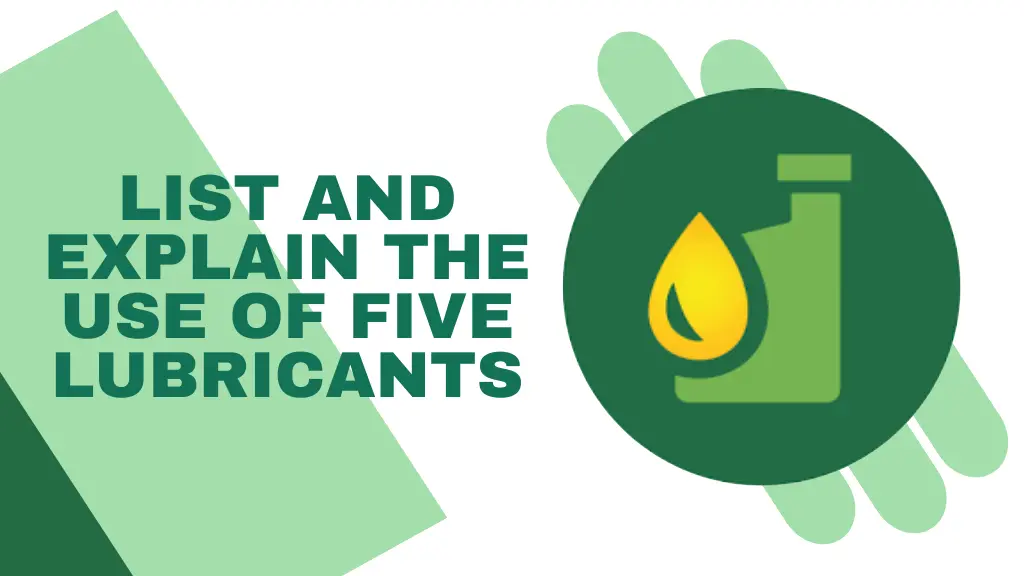Lubricants play a vital role in reducing friction, preventing wear, and ensuring the smooth operation of machinery and equipment. Whether in industrial settings, automotive systems, or household tools, the right lubricant makes a significant difference in performance and longevity. In this detailed guide, we will list and explain the use of five lubricants, covering their properties, applications, and advantages. By understanding the specific uses of these lubricants, readers can make informed choices for both personal and professional needs.
Understanding Lubricants and Their Importance
Lubricants are substances introduced between surfaces to reduce friction, minimize wear, and enhance efficiency. They may appear in liquid, solid, semi-solid, or gaseous form depending on the application. Beyond friction control, lubricants also serve purposes such as cooling, cleaning, corrosion prevention, and energy efficiency. Without lubricants, modern industries, automobiles, and machinery would face significant performance issues, downtime, and costly repairs.
Lubricants also contribute to energy savings. Studies show that proper lubrication can reduce energy consumption in machinery by up to 20%, as frictional losses decrease dramatically. This makes lubricants not only a mechanical necessity but also a financial and environmental one. Selecting the right lubricant is therefore a decision that affects both equipment health and overall operational efficiency.
List and Explain the Use of Five Lubricants
Engine Oil
Engine oil is one of the most widely recognized lubricants, primarily used in internal combustion engines. Its role goes beyond reducing friction; it also absorbs heat, prevents corrosion, and carries away contaminants. In automobiles, motorcycles, and heavy machinery, engine oil is critical for performance and efficiency.
For example, when a car engine runs, thousands of metal parts move rapidly against each other. Without engine oil, these surfaces would grind together, leading to overheating and rapid wear. Modern synthetic oils even include detergents that clean the engine and dispersants that prevent sludge buildup. Regular oil changes are essential for maintaining engine life and fuel economy. A well-lubricated engine not only runs smoothly but also consumes less energy, preventing unnecessary wear on metal surfaces.
Grease
Grease is a semi-solid lubricant made from oil combined with a thickening agent, such as soap. It is commonly applied in places where liquid oils would not stay in position, such as bearings, joints, and gears.
The use of grease provides long-lasting lubrication, prevents contamination from dust and moisture, and withstands high pressure. In industrial environments, grease is applied to conveyor belts, electric motors, and heavy machinery components that operate under constant stress. In the automotive world, it is found in wheel bearings, suspension parts, and chassis fittings.
Grease also acts as a protective sealant. By staying in place for long periods, it blocks dirt and water from entering delicate mechanisms. This property makes grease highly effective in outdoor machinery, agricultural equipment, and marine applications where exposure to harsh conditions is unavoidable. Its adhesive properties allow it to stay in place even under challenging conditions, making it one of the most versatile lubricants.
Hydraulic Fluid
Hydraulic fluid serves as both a lubricant and a power transmission medium in hydraulic systems. Found in machinery such as excavators, forklifts, and aircraft controls, this fluid reduces friction while enabling smooth movement of components.
Hydraulic fluid has unique properties that go beyond simple lubrication. It must remain stable under high pressure, resist foaming, and maintain consistent viscosity across a wide range of temperatures. In an excavator, for instance, hydraulic fluid transfers force from the control lever to the bucket, allowing precise digging and lifting. At the same time, it lubricates internal pump components, preventing overheating and wear.
Another important feature of hydraulic fluid is its ability to prevent rust and corrosion inside hydraulic lines. Because these systems are closed and under pressure, even minor contamination or lack of lubrication can cause severe breakdowns. The use of hydraulic fluid ensures operational safety and precision in systems where consistent force transmission is required. Without it, construction, aviation, and manufacturing industries would struggle to maintain efficiency and reliability.
Gear Oil
Gear oil is specifically designed for transmissions, gearboxes, and differentials. It provides protection against friction and heat in environments where gears are in constant contact under high pressure.
Unlike regular oils, gear oil is thick and fortified with extreme pressure (EP) additives. These additives create a protective coating on metal surfaces, allowing gears to withstand heavy loads without welding together under stress. In vehicles, gear oil allows smooth shifting and prevents grinding noises, while in industrial settings, it keeps conveyor drives and turbines running efficiently.
Gear oil also resists oxidation and foaming, two common issues that reduce lubricant effectiveness. For example, marine vessels use gear oil to protect propulsion systems exposed to moisture and high loads. Industrial mills, mining operations, and wind turbines also depend on gear oil to keep massive gears functioning without failure. Its additives help resist foaming, rust, and oxidation, ensuring equipment durability.
Dry Film Lubricants
Dry film lubricants are unique because they work without liquid or grease. Instead, they use materials such as graphite, PTFE (Teflon), or molybdenum disulfide to create a thin layer that reduces friction.
These lubricants are especially useful in extreme environments where traditional oils cannot survive, such as space applications, high temperatures, or vacuum conditions. For instance, spacecraft components often use dry film lubricants because they cannot rely on liquid oils in a vacuum. Similarly, in defense applications, firearms are treated with dry films to ensure smooth operation without attracting dirt or dust.
Another advantage is that dry film lubricants do not evaporate, leak, or drip, which makes them ideal for applications requiring clean, contamination-free surfaces. The use of dry film lubricants is common in aerospace, defense, and specialized machinery, where reliability under extreme conditions is critical. They offer excellent resistance to wear while eliminating the risk of liquid leakage.
Benefits of Using the Right Lubricant
Selecting the correct lubricant for each application is essential for efficiency, safety, and long-term savings. The right lubricant reduces maintenance costs, minimizes downtime, and extends the life of machines. In contrast, using an unsuitable lubricant can lead to breakdowns, reduced performance, and higher energy consumption.
For example, using regular engine oil instead of gear oil in a gearbox can result in rapid wear and eventual system failure. Similarly, applying grease where a hydraulic fluid is required would prevent proper force transmission. This is why industries spend significant resources on training, testing, and monitoring lubricant performance.
Key Considerations When Choosing Lubricants
Viscosity and Temperature Resistance
The viscosity of a lubricant determines how well it can flow under different temperature conditions. Engine oils, for example, are graded based on viscosity, ensuring proper performance in hot and cold climates. Selecting the wrong viscosity can result in either poor lubrication or unnecessary resistance to movement.
Compatibility with Materials
Not all lubricants are suitable for every surface. Some may cause chemical reactions or degrade seals, which can lead to leaks and equipment failure. Gear oil additives, for example, can damage yellow metal components if not matched correctly.
Environmental and Safety Factors
Modern industries emphasize eco-friendly lubricants that reduce pollution and are safer to handle. Biodegradable lubricants are becoming more common in environmentally sensitive sectors such as agriculture, marine transport, and forestry. Choosing eco-lubricants not only ensures compliance with regulations but also demonstrates corporate responsibility.
Common Misconceptions About Lubricants
A frequent misconception is that all oils or greases can serve the same purpose. In reality, each lubricant is engineered for specific conditions. Another myth is that more lubricant always equals better performance. Over-lubrication can actually damage components, attract dirt, and cause overheating.
There is also a belief that synthetic lubricants are unnecessary because natural oils are “good enough.” However, synthetic lubricants are engineered for superior stability, cleanliness, and performance, especially under extreme loads and temperatures. Understanding proper application is just as important as choosing the correct type.
FAQs
What are the five lubricants commonly used?
The five commonly used lubricants are engine oil, grease, hydraulic fluid, gear oil, and dry film lubricants. Each serves unique purposes depending on machinery and conditions.
Why is engine oil considered the most important lubricant?
Engine oil is critical because it reduces engine friction, absorbs heat, and prevents wear. Without it, engines would overheat and fail prematurely.
Can grease and oil be used interchangeably?
No, grease and oil serve different functions. Oil flows easily and cools components, while grease stays in place under pressure and seals against contaminants.
Are dry film lubricants better than traditional oils?
Dry film lubricants are better suited for extreme conditions where liquid oils cannot function, but they are not replacements for everyday lubrication needs like in engines or transmissions.
How often should lubricants be replaced?
The replacement schedule depends on the type of lubricant and application. Engine oil may need changing every few thousand miles, while gear oil and hydraulic fluid often last longer but still require monitoring.
Conclusion
In modern industries and daily life, lubricants are indispensable for smooth, efficient, and reliable operation of machines. By taking the time to list and explain the use of five lubricants, we can see how each type from engine oil to dry film lubricants serves distinct yet crucial functions. Choosing the right lubricant not only enhances performance but also extends the life of valuable equipment. With proper application and timely maintenance, lubricants remain a cornerstone of mechanical efficiency and durability.





